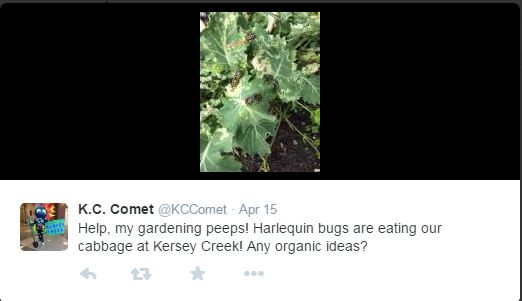Vegetable Gardening Help: Harlequin Bugs
by Laura Schumm, Community Kitchen Garden Horiculturist, Lewis Ginter Botanical Garden
A recent Tweet from the folks over at Kersey Creek Elementary School in Hanover County got us thinking about Harlequin bugs and how we can help provide suggestions for combating them organically.
There are many pesky insects pest that you will most likely run into sooner or later while tending a vegetable garden. The harlequin bug is one of them.
These bright red-orange and black insects are close relative to the stink bug and they love to feast on your vegetables. Harlequin bugs are known to be a major pest for plants in the Brassica family including broccoli, cauliflower, cabbage, kale, turnips, radish and Brussel sprouts, but they also might attack you tomatoes, corn, okra, squash, and asparagus.
Harlequin bugs are shield-shaped like stink bugs, but their bright colors give them away. The eggs are striped and barrel-shaped, and you will find them in masses. This is an insect that causes damage by sucking sap out of your plants, and they are dangerous to your crops at multiple life stages. The damaged caused can kill young plants and stunt the growth of more mature plants.
There are several organic options to consider when trying to control harlequin bug populations.
• Look for resistant varieties of vegetables.
• Keep the areas around your garden weeded — harlequin bugs prefer to overwinter in weedy/bushy areas.
• Inspect your plant often and hand-pick the insects and eggs that you find. Drop the insects into a bucket of soapy water.
• Use diatomaceous earth or organic insecticidal soap. This will strip the waxy coating from the exoskeleton of the harlequin bug, causing them to dehydrate.
• Use garlic/onion spray to repel the harlequin bugs; they can’t stand the smell.
• Plant companion plants. Try either nectar plants like borage or sweet alyssum to attract beneficial insects that will destroy egg masses or highly aromatic plants like garlic or mint to deter harlequin bugs from feeding.
To learn more about identifying bug and determining which are helpful bugs and which are harmful, be sure to read our blog post: Friend or Foe.
